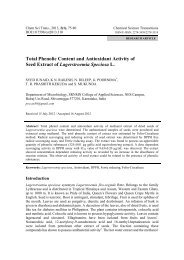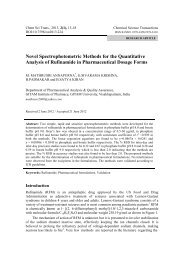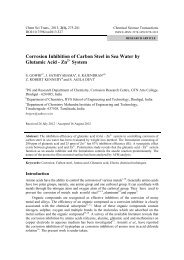Full Text - Chemical Science Transactions
Full Text - Chemical Science Transactions
Full Text - Chemical Science Transactions
Create successful ePaper yourself
Turn your PDF publications into a flip-book with our unique Google optimized e-Paper software.
414 Chem Sci Trans., 2013, 2(2), 413-422<br />
jute, hemp, abaca, coir and many others. Some of the potential applications of natural fibers<br />
such as flax, jute, banana, sisal, pineapple leaf fiber are in textile, packaging, low-cost<br />
housing, paper manufacturing industries, and other general applications. In addition, plant<br />
fibers can also be used to produce fuel, chemicals, enzymes and food.<br />
Synthetic fiber-reinforced composites offer many benefits such as high strength, light<br />
weight, water resistance, chemical resistance, high durability, electrical resistance, fire<br />
resistance and corrosion resistance. In fiber composites, fibers are used as reinforcement in<br />
matrix resin and offer the greatest strength of a structural material. Although synthetic fibers<br />
such as glass fibers, carbon fibers and aramid are high performance materials, they are less<br />
biodegradable and are sourced from non-renewable resources. Therefore, the use of natural<br />
fibers may bring environmental benefits as well as cost benefits.<br />
Natural fibers are sourced from plants which are renewable in origin and they can be<br />
easily biodegraded. Many researchers and technologists have utilized natural fibers in the<br />
fabrication of composites. It has been found that these natural fiber-reinforced composites<br />
possess good electrical resistance, chemical resistance, good thermal and acoustic insulating<br />
properties, and high resistance to fracture.<br />
Ample of studies on composites made by reinforcing natural fibers such as straw,<br />
banana, abaca, areca, hemp, sisal, jute, flax, pineapple, bamboo, kenaf, bagasse have shown<br />
that lignocellulosic fibers have the prospective to be a successful reinforcement in<br />
thermoplastic and thermosetting materials 1-17 .<br />
Although there have been several studies on the mechanical behavior of natural fiberreinforced<br />
composites, only few references are available on abaca fiber-reinforced<br />
composites 18,19 . Abaca or banana fiber is the cellulose fiber obtained from the pseudo-stem<br />
of the banana plant (Musa <strong>Text</strong>illis) and exhibits relatively good mechanical properties 20 .<br />
Currently abaca fiber reinforced composites are coming into interest due to the innovative<br />
application of abaca fiber in under floor protection of passenger cars by Daimller<br />
Chrysler 21,22 . It is described that abaca fiber has high tensile strength, resistant to rotting and<br />
its specific flexural strength is nearer to that of glass fiber 23 .<br />
Several considerations have to be taken into account in the design of natural fiber<br />
composites. Two major factors that limit the large scale production of natural fiber<br />
composites are the strength of natural fiber composites and water absorption of composites.<br />
The strength of natural fiber reinforced composites is very low compared to glass. This is<br />
due to the inaptness between the fiber and the resin matrix. Natural fibers absorb water from<br />
the air and the environment. This absorption deforms the surface of the composites by<br />
swelling and creating voids. The deformation lowers the strength of composites and<br />
increases the mass of composites.<br />
The irregularities of the fiber surface play an important role in the mechanical<br />
interlocking between the fiber and the matrix. Surface characteristics, such as wetting,<br />
adhesion, surface tension, or porosity of fibers, can be improved upon chemical<br />
modification 24 . The moisture absorbed by the fibers can be reduced by chemical<br />
modifications of fibers such as alkali treatment, acetylation, methylation, cyanoethylation,<br />
benzoylation, permanganate treatment and acrylation 25-29 .<br />
Many attempts have been made to study the properties of chemically treated natural<br />
fiber-reinforced polymer composites. But only a few studies on the mechanical properties of<br />
acrylic acid treated natural fiber-reinforced composite materials were reported. The<br />
Flexural properties, storage modulus and the glass transition temperature of composites made by





